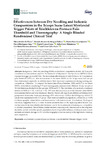Mostrar o rexistro simple do ítem
Effectiveness between Dry Needling and Ischemic Compression in the Triceps Surae Latent Myofascial Trigger Points of Triathletes on Pressure Pain Threshold and Thermography : A Single Blinded Randomized Clinical Trial
| dc.contributor.author | Benito-de-Pedro, María | |
| dc.contributor.author | Becerro-de-Bengoa-Vallejo, Ricardo | |
| dc.contributor.author | Losa Iglesias, Marta Elena | |
| dc.contributor.author | Rodríguez Sanz, David | |
| dc.contributor.author | López-López, Daniel | |
| dc.contributor.author | Cosín-Matamoros, Julia | |
| dc.contributor.author | Martínez Jiménez, Eva María | |
| dc.contributor.author | Calvo-Lobo, César | |
| dc.date.accessioned | 2020-01-02T17:54:34Z | |
| dc.date.available | 2020-01-02T17:54:34Z | |
| dc.date.issued | 2019-10 | |
| dc.identifier.citation | Benito-de-Pedro, M.; Becerro-de-Bengoa-Vallejo, R.; Losa-Iglesias, M.E.; Rodríguez-Sanz, D.; López-López, D.; Cosín-Matamoros, J.; Martínez-Jiménez, E.M.; Calvo-Lobo, C. Effectiveness between Dry Needling and Ischemic Compression in the Triceps Surae Latent Myofascial Trigger Points of Triathletes on Pressure Pain Threshold and Thermography: A Single Blinded Randomized Clinical Trial. J. Clin. Med. 2019, 8, 1632. | es_ES |
| dc.identifier.issn | 2077-0383 | |
| dc.identifier.uri | http://hdl.handle.net/2183/24563 | |
| dc.description.abstract | [Abstract] Background: Deep dry needling (DDN) and ischemic compression technic (ICT) may be considered as interventions used for the treatment of Myofascial Pain Syndrome (MPS) in latent myofascial trigger points (MTrPs). The immediate effectiveness of both DDN and ICT on pressure pain threshold (PPT) and skin temperature of the latent MTrPs of the triceps surae has not yet been determined, especially in athletes due to their treatment requirements during training and competition. Objective: To compare the immediate efficacy between DDN and ICT in the latent MTrPs of triathletes considering PPT and thermography measurements. Method: A total sample of 34 triathletes was divided into two groups: DDN and ICT. The triathletes only received a treatment session of DDN (n = 17) or ICT (n = 17). PPT and skin temperature of the selected latent MTrPs were assessed before and after treatment. Results: Statistically significant differences between both groups were shown after treatment, showing a PPT reduction (p < 0.05) in the DDN group, while PPT values were maintained in the ICT group. There were not statistically significant differences (p > 0.05) for thermographic values before and treatment for both interventions. Conclusions: Findings of this study suggested that ICT could be more advisable than DDN regarding latent MTrPs local mechanosensitivity immediately after treatment due to the requirements of training and competition in athletes’ population. Nevertheless, further studies comparing both interventions in the long term should be carried out in this specific population due to the possible influence of delayed onset muscle soreness and muscle damage on PPT and thermography values secondary to the high level of training and competition. | es_ES |
| dc.language.iso | eng | es_ES |
| dc.publisher | MDPI | es_ES |
| dc.relation.uri | https://doi.org/10.3390/jcm8101632 | es_ES |
| dc.rights | Atribución 3.0 España | es_ES |
| dc.rights.uri | http://creativecommons.org/licenses/by/3.0/es/ | * |
| dc.subject | Acupressure | es_ES |
| dc.subject | Myofascial pain syndrome | es_ES |
| dc.subject | Musculoskeletal diseases | es_ES |
| dc.subject | Trigger points | es_ES |
| dc.title | Effectiveness between Dry Needling and Ischemic Compression in the Triceps Surae Latent Myofascial Trigger Points of Triathletes on Pressure Pain Threshold and Thermography : A Single Blinded Randomized Clinical Trial | es_ES |
| dc.type | info:eu-repo/semantics/article | es_ES |
| dc.rights.access | info:eu-repo/semantics/openAccess | es_ES |
| UDC.journalTitle | Journal of Clinical Medicine | es_ES |
| UDC.volume | 8 | es_ES |
| UDC.issue | 10 | es_ES |
Ficheiros no ítem
Este ítem aparece na(s) seguinte(s) colección(s)
-
GI-UDISAP - Artigos [196]






